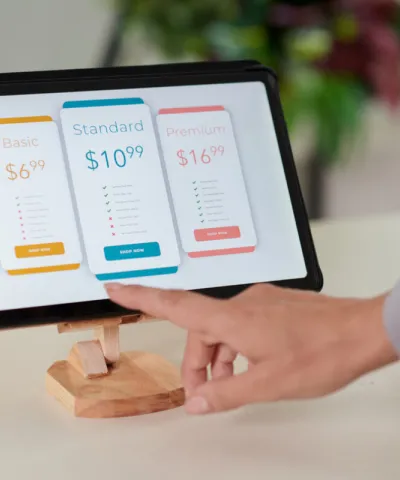Pricing strategy is primarily based on behavioral and economic psychology. Decoy pricing strategy leverages psychology to help you sell specific products more effectively. A deeper understanding of decoy pricing facilitates a better grasp of behavioral psychology and analogous pricing strategies.
Decoy pricing, also known as the asymmetrical dominance effect, is a strategic pricing method that influences consumer choice towards a more expensive or profitable option.
The tactic involves introducing a third product option (the decoy) that is less attractive than the other two available choices but similar tolike one of them in many respects. This decoy is typically priced to make one of the other options look more appealing.
For example, a business might offer three subscription plans: a basic plan at $5 a month, a premium plan at $15 a month, and a decoy plan that offers slightly fewer features than the premium but costs $14 a month. The presence of the decoy makes the premium plan seem more valuable, steering customers towards it, as it appears to offer a better cost-to-value ratio than the decoy.
This technique exploits cognitive biases in decision-making, encouraging consumers to choose the option that the seller wants to promote. This typically results in higher sales of the more profitable choice.
Using decoy pricing effectively requires a deep understanding of consumer psychology and market dynamics. It should be used ethically and transparently to avoid misleading customers, which could damage trust and brand reputation in the long term.
Behavioral economics
Pricing psychology involves several behavioral economics concepts.
The decoy effect
Economists have found that consumers change their preferences between price options when a third option is intentionally less attractive. This less attractive addition is the “decoy.”
The decoy must be strategically placed to make other options seem appealing. The lack of a reference product may result in a missed opportunity. When the comparison becomes feasible, people will adjust their thinking accordingly.
Anchoring
Anchoring is a cognitive bias relevant to behavioral economics.
People rely heavily on the first information they receive when making decisions. After receiving the first piece of information, additional information will be progressively less significant in their decision-making process.
For example, seeing a decoy product with a very high price sets the customer’s expectations about that type of product’s price. Next, the customer sees a similar product that is much less expensive. Their expectations are already anchored at the first price they saw. When they come across the next deal, they will process it relative to the anchor.
Loss aversion
Loss aversion is a general psychological concept that can also be closely tied to decoy pricing. It refers to the overall tendency of people to prefer avoiding loss over acquiring equal gains. That means that most people will choose to avoid losing $100 over the possibility of losing $100 at the possibility of gaining $500.
In decoy pricing, loss aversion makes customers sensitive to potential losses. Decoys can be presented as:
- Limited-time offers
- Seasonal discounts
These tactics subtly frame the decision to not purchase as a loss. If the customer wants the item in the future, the higher price is a loss, which they naturally want to avoid.
Gamification
Gamification means incorporating game-like elements into non-game activities. For example, you can add:
- Points systems
- Other rewards
- Competition
Gamification often means rewards, discounts, or choosing exercises. The idea is to make the customer’s decision-making process more engaging.
When to implement decoy pricing
Companies launching new products or services can implement decoy pricing. Otherwise, any situation where more sales are needed for a specific product may call for it. Here are some examples:
New products
When adding a new product to your listing, decoy pricing can make it more attractive.
Sales events
Decoy pricing is often used during sales events. These represent opportunities to strategically position some products or services above others. For products, this is also an opportunity to unload some items from your inventory.
Competition
Under some circumstances, decoy pricing can give you an edge in competitive markets. It changes the value proposition of your offer.
High-ticket purchases
Decoy pricing can be especially useful when selling expensive products or services. Customers are likely more sensitive to price differences and looking to save in these cases. Decoy pricing gives you one opportunity to differentiate your offer and anchor the lowest and highest prices in a way that enables greater profitability.
Digital marketing
E-commerce and any digital point of sale will leave many opportunities to implement decoy pricing easily.
Subscription models
As we saw in the previous example, subscription business models commonly employ decoy pricing, which is probably the most common application you’ve seen while browsing online.
How to implement decoy pricing
Determine the products for which you will use decoy pricing
First, choose which products or services could benefit from decoy pricing. These are the items you should promote to drive customer purchases.
Create pricing tiers
Companies must clearly distinguish between pricing tiers. The value proposition of the mid-priced option needs to be emphasized. So, develop a pricing tier system that includes the target product or service. Your decoy should be the one that appears more attractive.
Emphasize value
Highlight the benefits of the target product compared to the lower and higher-priced products. Make it clear why the target product is the superior option.
Guide your customers with choice architectures
Use behavioral economics concepts to guide your customers to the target product. This can involve the following steps:
- Anchoring the price with a decoy option
- Framing the target product as the “best value” or “best choice”
- Leveraging loss aversion
We help companies design choice architectures that guide consumers toward the desired outcome. Balancing strategic pricing with transparency is important to maintaining trust and loyalty among your customer base.
After this step, it’s essentially a matter of analyzing results and readjusting as necessary.
Analytics and decoy pricing
You will need to test your assumptions and analyze your results before and after implementing the decoy pricing strategy.
Companies engaging in decoy pricing must analyze the following:
- Market dynamics
- Competitor pricing strategies
- Consumer behavior
This information is used to identify new opportunities for implementing decoy pricing strategies. Research must be conducted before these strategies can be implemented.
After implementing decoy pricing strategies, analyze the results your strategy produces. Then, make any changes slowly and thoughtfully so you can see if your assumptions about customer behavior changes are valid.
At Simon-Kucher, we offer pricing strategy analytics based on behavioral economics principles. We can help guide you through your implementation and determine the optimal prices for each product.
Our experts are always happy to discuss your issue. Reach out, and we’ll connect you with a member of our team.


